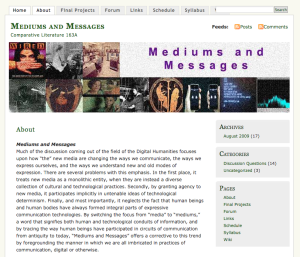Much of the discussion coming out of the field of the Digital Humanities focuses upon how “the†new media are changing the ways we communicate, the ways we express ourselves, and the ways we understand new and old modes of expression. There are several problems with this emphasis. In the first place, it treats new media as a monolithic entity, when they are instead a diverse collection of cultural and technological practices. Secondly, by granting agency to new media, it participates implicitly in untenable ideas of technological determinism. Finally, and most importantly, it neglects the fact that human beings and human bodies have always formed integral parts of expressive communication technologies. By switching the focus from “media†to “mediums,†a word that signifies both human and technological conduits of information, and by tracing the way human beings have participated in circuits of communication from antiquity to today, “Mediums and Messages†offers a corrective to this trend by foregrounding the manner in which we are all imbricated in practices of communication, digital or otherwise.




